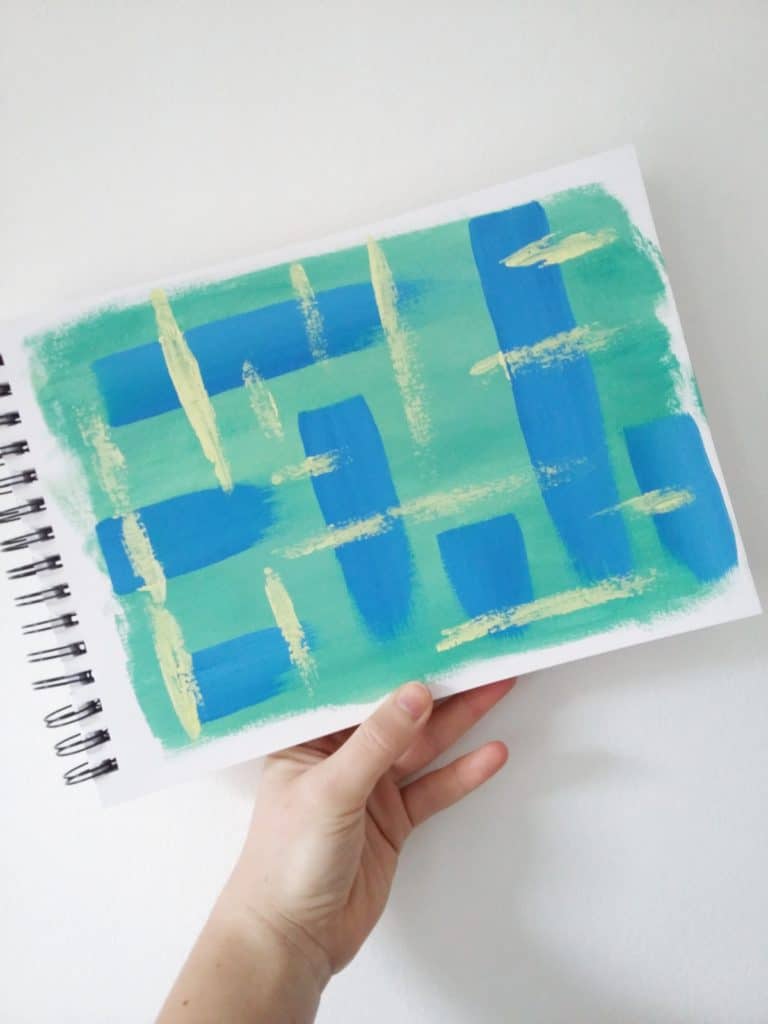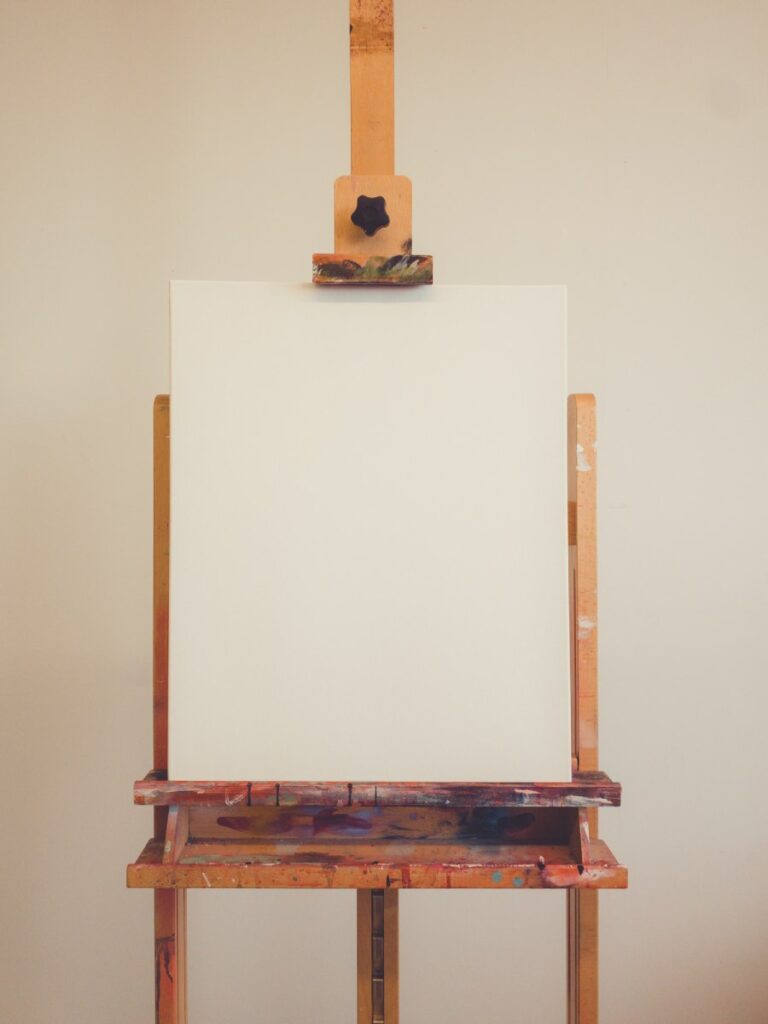If you’re new to painting with acrylics, you may be wondering which surfaces are best to paint on and why. In this blog post I look at four different surfaces for acrylic painting along with the pros and cons for each to help you decide which to try.
Acrylic paints are very versatile and can be used on many different surfaces. You can paint on most surfaces as long as they aren’t greasy or completely smooth. This is because the paint needs a little bit of texture (“tooth”) to stick properly.
The surfaces mentioned in this article aren’t the only ones you can paint on with acrylics. But there are definitely a few surfaces that are particularly popular for acrylic painting, and that’s what we’re going to look at today.
So let’s get into it!
Sign up for my monthly emails of creative tips, tutorials and DIYs and get 31 free creative prompts!

You can unsubscribe at any time
1. Paper
Paper is a great surface to start acrylic painting with, but it’s definitely not just for beginners. In fact, it’s one of my favourite surfaces.
I know people often like starting with paper as it costs less than buying canvases. They feel that it’s less of a waste if they mess their painting up. (Although of course the beauty of acrylics is that you can paint over acrylic paint when it’s dry, so it’s really not that big a problem 🙌)
- Related: How To Learn From Creative Mistakes
It’s best to use thicker paper when painting with acrylics. Regular printer paper is no good as it will buckle and crinkle as the paint dries. You can get specially made acrylic paper, but watercolour paper and mixed media paper are just as good. I love this Daler Rowney Mixed Media Spiral Sketchpad.
Usually, I find paper with a weight of around 300gsm is ideal, but a little less is also fine (the mixed media paper I like is actually 250gsm).

If you paint on paper, it’s best to frame it when you want to display it. You can also mount it on a cradled wood panel if you prefer, and if you do this it’s best to varnish it to preserve your painting. Acrylic paint attracts dust so it’ll be much easier to keep clean if it’s varnished.
Pros of acrylic painting on paper
- Relatively cheap
- Easy to store
- Can be a good option for beginners
- Easy to get hold of
Cons of acrylic painting on paper
- Needs to be framed or mounted on a panel before it can be hung on the wall
2. Canvas board
Canvas board is a good step up from paper, being just that bit more rigid. It can also hold more paint than paper can, so it might be a better choice than paper if you like to use thick paint to add texture.
Canvas boards are also easy to store, taking up much less room than canvases. They also cost less than canvases, although more than paper.
I’d probably frame a canvas board, even if I used a frame without glass. If you chose to go without the glass, you’re better off varnishing your painting. Ultimately, it’s down to personal preference, and you could hang a canvas board without a frame if you chose to.
Pros of acrylic painting on canvas board
- Relatively cheap
- Easy to store
- A nice intermediary between paper and canvas
Cons of acrylic painting on canvas board
- Requires framing to look its best on the wall
3. Canvas
If you think of painting in a traditional sense, you probably think of works on canvas. The texture of canvas is very satisfying to paint on. Although it’s more expensive than paper and canvas boards, it’s possible to buy budget options and multipacks that aren’t bad value at all.
If you paint often and complete paintings quickly you may find you quickly end up with storage issues if you use canvases.
Pre-made canvases generally come ready primed. The cheaper they are, though, the more likely it is that you’ll need to apply another coat of gesso to remedy a patchy surface. In the past, I’ve used a cheap canvas and found the paint didn’t adhere well. If that happens to you, you may need to give the canvas an extra coat of gesso.
With canvases, you have the option of framing them or not. If the sides of the canvas are painted, either one uniform colour or as a continuation of the painting, there’s no need to frame it. I’ve seen canvases in floater frames which look really effective. (Check out this pin if you’re not sure what a floater frame looks like!)
It’s best to varnish your finished canvas, whether you’re framing it or not.

Pros of acrylic painting on canvas
- They’re readily available in lots of sizes
- They often come ready primed
- Doesn’t need framing (although you can if you like)
Cons of acrylic painting on canvas
- They’re not the cheapest option
- Some people don’t like the give or “bounce” you get when painting on canvas
4. Wooden panels
Wooden panels have become more and more popular for acrylic painting over the years, as they provide a lovely rigid surface for painting on. Wood also has a fair bit of texture.
Most wooden panels are fairly lightweight, even if they’re cradled (that is, they have the frame on the back, like the stretcher bars of a canvas, to keep the panel rigid and prevent warping).
But something to bear in mind if you’re painting on plywood or other reclaimed wood is it’s likely to be heavier than a canvas of the same size. If you paint a lot of large paintings, give due consideration to the fittings and fixtures you’ll need when you hang them.
It’s best to prime wood panels before painting on them. If you want to keep the warm wood colour as a base, try using clear gesso instead of white. You could even try experimenting with a small piece of wood, priming half with white gesso and half with clear. That way you can see how much of a difference the natural colour of the wood makes as a base for your painting.
Framing isn’t necessary for cradled wood panels. You can frame uncradled panels but if it’s a large painting, be aware that a frame will add extra weight. And once again, you should varnish a painting that’s uncovered to protect it and make it easier to keep clean.
Pros of acrylic painting on wooden panels
- Looks great
- Can withstand a lot of paint
- Cradled panels don’t need framing (just paint the edges)
Cons of acrylic painting on wooden panels
- Can be expensive, especially larger sizes
- Often come unprimed, which isn’t ideal if you want to get straight into painting (although some people prefer them unprimed!)

Can you use acrylic paint on any surface?
You can paint on most surfaces that aren’t greasy or completely smooth. As I mentioned above, the paint needs a little bit of texture or “tooth” to stick properly and create a long-lasting painting.
If you paint on a surface that’s too glossy and untextured, you might find your painting peeling off again when it’s dried (even if you’ve prepared and primed the surface).
You can create what’s called an acrylic skin using smooth plastic or glass. To do this, paint directly onto the glass or plastic and allow it to dry. Then you can peel the skin off the surface and incorporate it into another painting.
How to prepare a surface for painting on
You can prepare suitable surfaces for painting by priming them with gesso. Acrylic gesso is basically paint with the addition of a gritty substance (often chalk) to create texture on your painting surface.
Gesso is available to buy in white, black and clear. You can also add a bit of colour to it by mixing in some acrylic paint.
A couple of coats of gesso will really help your acrylic paint stick to the surface you’re painting on and make sure the painting lasts well.
So there you have it — four surfaces for acrylic painting and their pros and cons. Which ones have you tried and which is your favourite? Has this article tempted you to try something different? Let us all know in the comments.
* That’s an affiliate link. This means I may make a small commission if you buy after clicking that link, but at no extra cost to you. Thanks for supporting Birch & Button!
About Stacey

I’m Stacey and I’m a blogger, abstract artist and freelance writer. My aim is to help busy people feel inspired and get more creative with tutorials, hints and tips.
I live in Cardiff with my partner and dog, and in my free time you’ll find me hiking, reading, painting or sampling a craft beer or two.

